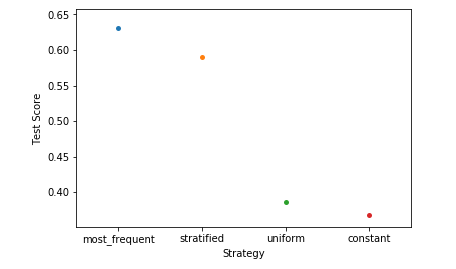ML | Dummy classifiers using sklearn
Last Updated :
28 Nov, 2019
A dummy classifier is a type of classifier which does not generate any insight about the data and classifies the given data using only simple rules. The classifier’s behavior is completely independent of the training data as the trends in the training data are completely ignored and instead uses one of the strategies to predict the class label.
It is used only as a simple baseline for the other classifiers i.e. any other classifier is expected to perform better on the given dataset. It is especially useful for datasets where are sure of a class imbalance. It is based on the philosophy that any analytic approach for a classification problem should be better than a random guessing approach.
Below are a few strategies used by the dummy classifier to predict a class label –
- Most Frequent: The classifier always predicts the most frequent class label in the training data.
- Stratified: It generates predictions by respecting the class distribution of the training data. It is different from the “most frequent” strategy as it instead associates a probability with each data point of being the most frequent class label.
- Uniform: It generates predictions uniformly at random.
- Constant: The classifier always predicts a constant label and is primarily used when classifying non-majority class labels.
Now, let’s see the implementation of dummy classifiers using the sklearn library –
Step 1: Importing the required Libraries
import numpy as np
import pandas as pd
from sklearn.model_selection import train_test_split
from sklearn.neighbors import KNeighborsClassifier
import matplotlib.pyplot as plt
import seaborn as sns
|
Step 2: Reading the Dataset
cd C:\Users\Dev\Desktop\Kaggle\Breast_Cancer
df = pd.read_csv('data.csv')
y = df['diagnosis']
X = df.drop('diagnosis', axis = 1)
X = X.drop('Unnamed: 32', axis = 1)
X = X.drop('id', axis = 1)
X_train, X_test, y_train, y_test = train_test_split(
X, y, test_size = 0.3, random_state = 0)
|
Step 3: Training the dummy model
strategies = ['most_frequent', 'stratified', 'uniform', 'constant']
test_scores = []
for s in strategies:
if s =='constant':
dclf = DummyClassifier(strategy = s, random_state = 0, constant ='M')
else:
dclf = DummyClassifier(strategy = s, random_state = 0)
dclf.fit(X_train, y_train)
score = dclf.score(X_test, y_test)
test_scores.append(score)
|
Step 4: Analyzing our results
ax = sns.stripplot(strategies, test_scores);
ax.set(xlabel ='Strategy', ylabel ='Test Score')
plt.show()
|

Step 5: Training the KNN model
clf = KNeighborsClassifier(n_neighbors = 5)
clf.fit(X_train, y_train)
print(clf.score(X_test, y_test))
|

On comparing the scores of the KNN classifier with the dummy classifier, we come to the conclusion that the KNN classifier is, in fact, a good classifier for the given data.
Like Article
Suggest improvement
Share your thoughts in the comments
Please Login to comment...